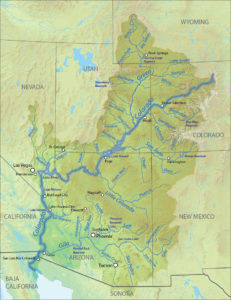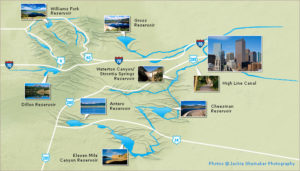Water
I spent thirty years in the water business. I was one of the troops, not a manager or staff person. I did, however, do what I could to keep up with developments in the water and wastewater business. With the Clean Water Act and the Environmental Protection Agency, rivers no longer catch fire, and our fresh water. Supply is in much better shape than, say, the 1950’s.
I worked at the Greeley, Colorado wastewater plant for three years. The water we sent to the river met EPA standards until the Cache La Poudre flooded and washed out the pipe carrying water from one side of the river to the other for final treatment. Lots of raw sewage went into the river for about a week until an emergency pipeline was laid on the highway bridge next to the plant.
An old adage in the wastewater business goes, “The solution to pollution is dilution”. That saying is mostly obsolete, but during that flood there was plenty of water for dilution. We had to wear hip waders to get around the north side of the plant, flooded with almost three feet of water.
Here is a big part of the water story in the American West. There is either too much water or not enough. Here on the Colorado Front Range a water crisis is slowly developing. The available water is starting to run out. Half of Denver Water’s water supply comes under the Continental Divide from the Colorado River. There is little more water available from the river for the Denver Metro population except from spring runoff, when there is more water than can be stored. Most years.
Other years, the snowpack is down, spring runoff is low, reservoirs drop, and worry starts. Water supply fluctuates, but demand only increases. Oh, wait, during a big drought recently, the Denver Water Board shifted its priority from dam building and water diversion to conservation. It worked, and continues to work, not just with Denver. Another water source is also coming into use.
Water law says if you use water from your nearby stream, you must return what you didn’t use to the stream. Water users downstream get lots of their water from return flows from irrigation or wastewater plant outflows. Water law also states that water you divert from another basin does not have to be returned. You can use it to extinction. So what once went downstream is being captured in new reservoirs downstream made from old gravel pits and used for water exchanges, where downstream users trade their upstream water rights for return flow water from Denver. The potato and corn fields don’t seem to mind.
The other thing happening is taking that foreign water, treating it, and pumping it upstream for reuse. At this point it is mostly for irrigation of parks, golf courses, and the like, but it is also being treated to drinking water standards. Yes, you might be drinking water that once was sewage. Not to worry, think about Omaha, St. Louis, Memphis, and New Orleans. What are they drinking?
Eventually this will all end. The water will run out. At some point, tap fees for new housing or industry will soar and development will go elsewhere. The growth cannot continue indefinitely. The same thing will occur in the entire Colorado River Basin. Despite every effort to conserve or store more water, it is going to run out. The new growth will then go to Cincinnati and Birmingham, all those wet places back East.. They have lots of water.

